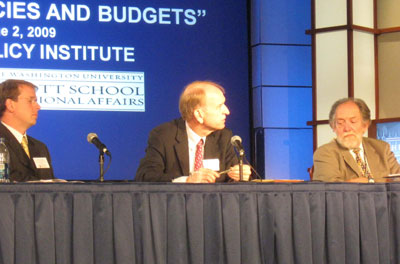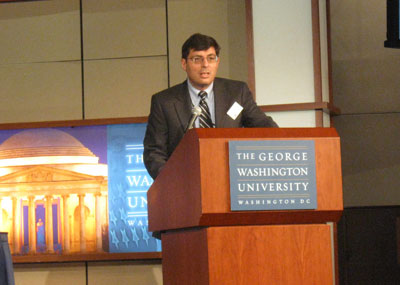Space policy 101: civil space 2009<< page 1: civil space programs: waiting for Godot In-house talent and international cooperationDuring the question and answer period Scott Pace noted that NASA over the years managed to maintain a fair amount of in-house talent for designing spacecraft, which gave the agency a better ability to monitor its contractors, particularly in the robotic spacecraft field. In contrast, the DoD lost much of its in-house talent and suffered significantly in the area of space acquisition after the Cold War. Mike Griffin sought to expand upon the agency’s in-house talent for the Constellation program and as a result NASA is conducting its procurement process significantly differently than it has in the past. He asked if this was a good approach. Damon Wells, the OSTP analyst, responded that the government does require a good amount of in-house expertise in order to monitor its contractors. “It’s on a pendulum,” Wells explained. During the 1990s the government pushed a lot of that talent out, and now it is swinging back, trying to reacquire it. But “there’s no one-size-fits-all answer to this,” he added. Different sectors have different requirements.
Another questioner asked about international cooperation in the Constellation program, prompting one panelist to remark that the space station did not become truly international until the 1990s. Marcia Smith corrected him, noting that the space station had included international partners from the start, and that Vice President Al Gore had ruffled some feathers in 1993 when he declared that incorporating the Russians into the space station had made it “truly international.” One of the questions posed to the panel was the degree to which consolidation made sense. This echoed a view oft-expressed in the space activist community—and occasionally within the political realm—that NASA’s Earth sciences should be merged with NOAA’s operations. The idea did not gain much traction with the panelists who noted that although there are opportunities for synchronicity, recent experience with the creation of the Department of Homeland Security offers reason for caution. The costs of consolidating and aligning different agencies’ personnel, budgets, facilities and operations can be high in the short term, and very disruptive to normal operations. “You lose years,” one panelist replied. Another view of the elephant in the roomThe next panel consisted of several congressional staff members. Unlike the executive branch staffers, they had a more independent view of current space policy issues. Jeff Bingham, a Republican staffer from the Senate Committee on Commerce, Science, and Transportation, briefly discussed the new Human Spaceflight Review. He said that he thinks that the commission’s charter “tends to limit the options” and that it needs to have a more expansive view. It should ask “what does the nation need?” not “what will fit in the budget?” Bingham noted that the Congress authorized a lot more money for NASA than was actually requested by the Bush administration. He said that International Space Station science in particular took a major hit. Bingham said that NASA had a commitment to its scientific principal investigators (PIs), not simply its international partners, and that it clearly had not honored that commitment. There were originally over 900 PIs lined up to do research on the ISS, but now there are less than 100. Echoing a complaint made by former NASA administrator Mike Griffin, Bingham added that in his view the OMB was doing things that it was not authorized to do and that it was “needing adult supervision.” Following Bingham was Richard Obermann, the staff director of the House Committee on Science and Technology and a longtime expert on American space policy. Obermann said that although the Obama administration has taken some of its first steps in space policy, such as creating the Human Spaceflight Review and nominating a NASA administrator, there remain many areas where “we don’t know what their plans are.” These include:
Obermann noted that the out-year funding profile for NASA does not include a funding wedge for the International Space Station. Considering that, as Marcia Smith said, NASA still has too much to do without sufficient funding, the agency will face “some tough decisions about what to take off the plate.” Chris Homan, a staffer in the office of Senator Richard Durbin (D-IL) said that his job primarily focuses on foreign affairs. However, he does have responsibility for space issues in the senator’s office, and offered his impression of what he thinks is the broad view of NASA by the Congress. Homan said that there has long been skepticism in Congress about NASA based upon the belief that the agency over-sold both the Space Shuttle and the International Space Station. “There is a legacy of some negative feelings,” he explained. He also believed that there was broad support for what Mike Griffin was doing at NASA before he left. Homan believed that the previous administration “missed an opportunity” to get more money for the agency to close the looming spaceflight gap. Last year, when the Russians and the Georgians were fighting, NASA was at a disadvantage in negotiating to purchase more Soyuz spacecraft. Instead of the administration choosing to seek funds to try and close the gap, they left NASA hanging, resulting in the agency getting charged more for purchasing Soyuz.
Waiting for dollars, and BoldenDuring the question session a member of the audience asked about the potential multiplier effect of space research. How many dollars are earned by each dollar spent on space? Bingham replied that he currently had a proprietary study of research conducted on the International Space Station to date—not simply the planned research, but the research already performed during the ISS’s construction phase—that indicates substantial payback to the economy for each dollar spent on research. However, he said that he would be very interested to know about the assumptions in the model. So it’s unclear how many dollars are returned for each dollar spent on space research. “But even it’s one, how many government programs give you a dollar back?” he joked. Obermann added that it was very hard to find credible economic models. But for the members of Congress, he explained that it is largely a qualitative question, not a quantitative one. Members of Congress look at past examples now paying off, and to them future expenditures represent a certain “leap of faith.” Homan added that Senator Durbin talks less about economic payoffs than soft power trade-offs. The United States accrues other benefits, such as prestige and a desire for cooperation with NASA, as a result of its space research.
Bingham was asked about the schedule for the confirmation hearing for the nominated NASA administrator Charlie Bolden, and deputy administrator, Lori Garver. Bingham said that the committee will not even begin to discuss scheduling options until they have received the paperwork on the nominees, and it had not arrived yet. He added that there were so many nominees up for confirmation hearings that it was presenting the Senate with problems scheduling them with the agencies, and they were resorting to “bundling” the nominees’ hearings. There were few openings in the schedule—Bingham knew of only one hearing opening in June and two in July. He added, however, that he believed that the vetting process for the nominees had been pretty thorough this time. But he added, “you gotta have a hearing at some point.” The keynote speaker closing the morning sessions on civil space was acting NASA Administrator Chris Scolese. Had the symposium taken place two weeks earlier, the audience would have been hanging on Scolese’s every word. But now that it’s simply a matter of time until Charles Bolden becomes administrator, Scolese had less opportunity to make news. Scolese’s talk (his charts are available at the Space Policy Institute website) was essentially an overview of NASA’s current status, starting with a pie chart demonstrating that NASA is essentially the third largest research and development agency in the US government, behind DoD and the National Institutes of Health. He then explained NASA’s current budget situation and what the agency wants to do with its fiscal year 2010 money, including flying six shuttle launches, one of which will carry the Alpha Magnetic Spectrometer to the space station. Scolese explained that options for ISS operations beyond 2016 will be evaluated by the Augustine committee. He also continued a theme pushed by many NASA officials over the past year that the Constellation program, including the much-maligned Ares 1 rocket, is already building hardware and conducting tests. He showed numerous photographs of tests of the launch abort system, Orion capsule, and J-2X rocket engine components. The launch test of the Ares 1-X is scheduled for later this year. NASA is already significantly down the path toward building the Ares 1 and the Orion, something that will surely be evaluated by the Human Spaceflight Review committee. Waiting for the elephantIf there was a single theme that emerged during the various presentations about the civil space program, it was that despite the best budget NASA has had in years, there is considerable short-term uncertainty about the agency’s direction. Everybody, it seems, is waiting to see what comes out of the Human Spaceflight Review, and that uncertainty goes beyond the relatively simple issue of architectural choices (i.e. Ares 1 vs. EELV) to include questions about whether the United States should return humans to the Moon at all, and what to do about the nearly-complete space station. This uncertainty turned real only two days after the symposium when the Commerce, Justice and Science Subcommittee of the House Appropriations Committee slashed $670 million from NASA’s exploration account. The subcommittee’s chairman described it as a “time-out” budget action based upon the uncertain future of the exploration program. Home |
|

